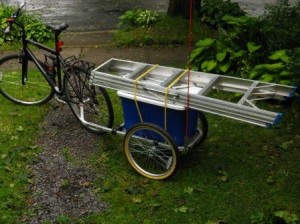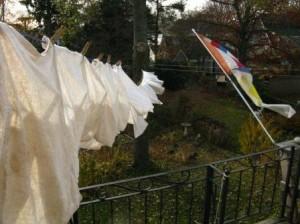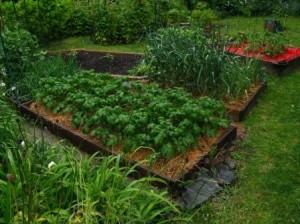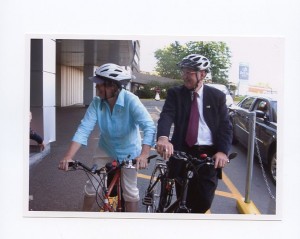Wednesday
Community Articles, Featured StoriesDoing it at Home
The radical simplicity of the little changes: how we drive, heat our homes, do housework, and relate with food.
By Hudson Shotwell
A few years ago, in order to prepare for a reasonable, practice-relevant descent down the other side of the oil peak, Janet and I decided to try living daily life as though the end of cheap energy, and the karmic consequences of that for every economy and person on the planet, were as inevitable as birth, old age, sickness and death. We’re too old to be extreme any more, so cutting back on this and that, a little bit this year, a little bit next year, was the middle-way, Mahayana approach to becoming more sustainable — whatever sustainability might eventually turn out to be.
Now we’re thinking the non-hysterical, middle-way approach is the likely methodology for your garden-variety environmental Buddhist, if he or she decides to emit less greenhouse gas into the atmosphere. It turns out to be nothing flashy or radical, just a gradual path.
If Shambhala is Mahayana/Vajrayana activity, the personal attempt to stop climate change might be the Mahayana while the Vajrayana edge is hopelessness, in the absolute sense. Curbing global warming by insulating the house is hopeless, but so was continuing to build the shedra, as Trungpa Rinpoche did even as the Chinese were invading Eastern Tibet. Hanging out the laundry instead of using the drier won’t stop continental drift, it’s just something you do. In keeping with the “one mandala, many paths” theme of the last congress, the path we’re on is greenish and we’re riding a bike down it. The air, the earth and the trees you encounter on this path are just exquisite.
Where did we go wrong? How did two elderly practitioners end up holding signs in demonstrations that say, “Under 2’,” or “Reduce Energy by 6%. Hang It Out?” We gave that up after People’s Park and now we’re back at the demonstrations and some of our friends won’t talk to us anymore — maybe it’s the rain pants. We didn’t plan it this way, it just sort of happened, like someone getting addicted to cigarettes or developing an ego. It was Buddhadharma in the vernacular, a version of, “Death is real, comes without warning, this body will be a corpse.” Books on Peak Oil led us to others by Tim Flannery, Jared Diamond, Richard Heinberg et al and to websites like www.energybulletin.net. Finally, like many others over the past few years, we decided to take an inelegant, body-mind leap and try to do something for the environment where we live.
 The Car
The Car
Transportation was first. We began to regard the Cannondale, rather than the Camry, as our primary vehicle. Once the muscles were onboard, the hybrid bike, with its brilliant mechanics, rear rack and panniers, assumed the role of Preferred Way to Get Around. This was big. Automobiles — those fancy, stinking metal boxes on wheels — are co-opting the identity formation of human beings. We are the vehicles we drive: we alter the landscape for them, we create wider and wider parking spaces for our bigger and bigger babies even as we ourselves get wider and wider. They can go faster than the law allows so we share their frustration at speed limits. A slow, crappy car is the cause of suffering – when it could be a blessing.
Riding the Cannondales day after day slowly shifted our vehicle-identity allegiance from stinking box to limber, self-propelled two-wheeled stallion, free from the constraints of fossil fuel. Using the bike instead of the car for errands at night within a three-mile radius still takes discipline, but we understand that paramita so there’s no problem. We use the car for what cars are really for: airport runs, hauling stuff, going to the beach. It’s still nothing but a monster machine in a nice wrapping, though.
 The House
The House
Next came energy and the house. We figured we’d do one thing a year to get the house to use less energy. First we installed an efficient furnace, then we changed out the old windows, insulated the walls and did and all the other stuff you see on TV shows. Last spring we popped for a solar thermal hot water system for domestic water. The day they installed it, we had 60 gallons of 140’ water in the new tank, heated by the sun. Everyone who can, should think about getting one of these systems on their roof: it’s technology from the seventies but still the most bang for your solar buck, at least right now. I reckon we’ll use a thousand liters less fuel oil per year and the system will pay for itself in five years. The bottom line is that all this green energy retrofitting began to add up, bit by bit. Together with the wood stove we halved our oil and electric use.
What’s Shambhalian about going to store and spending thirty bucks on a clothesline, two aluminum wheels and clothes pins? Nothing, except that a Shambhalian did it. We installed the line off the back deck and now we fight over who gets to hang out the clothes. Shambhala loves a good fight. We fight over the clothes and in the mean time we don’t use the dryer any more. It sits unused most of the time, like the car. You see more people with clotheslines these days, just like when Granny had them. We’re all saving about 6% off the electric bill, Buddhist practitioner or not. We spend our savings on retreat, they spend theirs on… well, it’s none of my business.
 The Food
The Food
As for food, the hippies were right: grow your own. We started making our own bread and yoghurt again and in a fit of retro-pioneer frenzy I bought a dehydrator to dry herbs and tomatoes. Early one spring we watched Margaret Drescher show a group of people on a lawn how to construct a raised bed. Nail together a box of four boards, put cardboard over the sod, fill with soil. “Plant some potatoes in it.” We all went home looking for a place with six hours of sun. None of this is news to lots of Shambhalians who grow their own food, especially our European friends, but having a potager is just a must.
Urban gardening and the Permaculture movement won’t feed all the people on the earth but again, the middle way has its advantages. One thing leads to another. Today’s radical move is tomorrow’s middle-way. From the first raised bed, we added four in the back yard — now we’re involved with the Peninsula Urban Garden Society (PUGS), an organization with two garden collectives in Halifax. The Gorsebrook site has forty, ten-by-ten raised bed plots on common land, gardened by a variety of people, including a number of Shambhalians, with the blessing of the City of Halifax. We grew so much food in our ten by ten plots some of us had to give some to other people. You hear that home-grown vegetables taste better than store-bought, but it wasn’t until we roasted a few of our babied Red Chieftains that we experienced the exploding ayatana of taste. All we did was add compost and Mother Earth gave us a potato that melts in the mouth like pure cream or fresh butter.
 Now How Hard is That?
Now How Hard is That?
There are thousands of stories in the Kingdom and this is just one of them. The challenge for Buddhists who engage in environmentalism, deciding to press for a change of behavior or policy within Shambhala or without, is to join one’s advocacy with a sense of emptiness: then you get results. It’s the same old story. First you work on yourself, then you turn the protest sign outward.
 __________________________________
__________________________________
Hudson Shotwell was born in Los Angleles, spent seventeen formative dharma years in Boulder and moved to Nova Scotia with his family in 1989. He and his wife, Janet Moe, have owned and operated Trident Booksellers and Café in Halifax since 1992. For the past four years he’s been a member of the board of the the Ecology Action Centre, a Nova Scotian environmental non-governmental organization, representing its Energy Issues Committee






Jan 18, 2010
Reply
No one could say it, or do it, better.
Thanks for not only doing it but writing with honesty, practicality and wit.
You two inspire the rest of us.
Love, Margaret
Jan 13, 2010
Reply
Thanks for a great little article! Love your pulley clothesline. We live in an apartment and don’t have a clothesline, but still air dry our clothes by using this clothes drying rack – being round it works really nice under a ceiling fan!
Dec 6, 2009
Reply
Thanks Hudson — really enjoyed reading your article! The thing I’ve missed the most by moving out of my house into, first, the Condo and now an apartment, is having to use a clothes dryer (for some things part way) for the first time in many years. My house in Boulder did not have a dryer, except for the solar one outside which I used for 13 years 12 months out of the year — nor did the house in Halifax — another 8 years. Freeze-dried is great!! I understand why Hudson and Janet fight over hanging the clothes outside even in the winter — it’s a superb and satisfying activity. Now I hang sheets over doors (once they’ve had 2-3 minutes in the dryer to shake out the wrinkles — something the wind used to do) and hang most other stuff on racks (except for towels). And although I don’t feel comfortable taking up the bicycle (after 50 years), I walk as much as I can, leaving the car parked in a pricey garage. Someday!!
Dec 5, 2009
Reply
Thank you, Hudson, for a fun read. Educational and inspiring, too. We’ve made some changes and I now feel a little stuck. Your incremental appraoch is helpful.
Dec 5, 2009
Reply
You gave this relating but non-Buddhist body a good laugh. Thanks for sharing.
Dec 5, 2009
Reply
Great article, Hudson and Janet.
One of the interesting things about living part of the year in Patzcuaro, Mexico, is the environmental things I’ve learned to watch. Besides doing the laundry in cold water and hanging it out to dry in the sun, I have to watch the potable water and find that, for example if I don’t drink the water I leave by the bed at night, I can pour it in the kettle and boil it with the tea water at breakfast. I turn the boiler down to tepid at night and turn it up again in the morning for a shower. While I wait the 20 min. for the water to heat, I can wash the dishes, which primes the pump….and so on. I don’t have a car but take the “combi” (a small van) which passes a half block from my house, approximately every 30 seconds. And I’ve just started working with a local small-crop farmer to experiment with growing interesting varieties of tomatoes — no results as yet!
Dec 2, 2009
Reply
thanks so much, Hudson. so down to earth, simple and sensible. all our “expertise” gets us off-track.